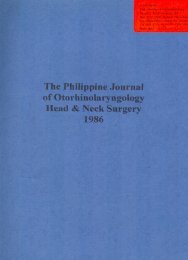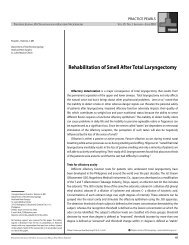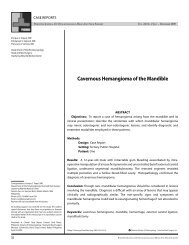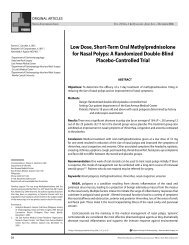Create successful ePaper yourself
Turn your PDF publications into a flip-book with our unique Google optimized e-Paper software.
An antibiogram was constructed (Figures 3, 4 and Mackowiak (1978) cultured sinus tract drainage in<br />
5) and it showed that for the three most common patients with chronic osteomyelitis and found that<br />
organisms, the quinolones are the most effective if the culture was positive for Staphylococcus aureuL<br />
antibiotics. This may be due to the fact that this there was good correlation with culture reports of.<br />
is a new drug and resistant strains have not yet the operative specimens. However, if the culture of<br />
developed. The use of ciprofloxacin has recently the sinus drainage was another organism,there was a<br />
been underscored in a study by Picirillo (1989), poor correlation. Assuming that the same pattern<br />
considering that the drug is effective in a wide range exists in the middle ear cleft since there is a similarity<br />
of both gram positive and gram negative organisms, in the organisms implicated, this might suggest<br />
However, the use of this ciprofloxacin is not recom- that the specimen obtained from the external auditory<br />
mended for chidren nor as a first line drug in the canal may not be the same as those from the middle<br />
management of COM. Gentamicin, which is corn- eardischargewiththosetakenintraoperativelyeg, bone,<br />
monly used otic solution, still has a good sensitivity cholesteatoma and granulation tissue. Computation<br />
(93.7%) for the organisms. The commonly prescribed of the predictive value of transcanal aspirates showed<br />
oral antibiotics ampicillin, trimethoprim, chlo- that there is good to excellent correlation for these<br />
ramphenicol and cephalexin showed a < 80% sensi- organisms using the rating of agreement by Kappa<br />
tivity pattern. This could probably be attributed statistics. This study specifically Shows that when<br />
to the administration of antibiotics intravenously or anyone of the three organisms is cultured, there is<br />
previous oral intake prior to the collection of a positive correlation in 90% of cases. This finding<br />
specimens, may be very imporant in the clinical setting as the<br />
antimicrobial treatment of COM can be fairly accu-<br />
The role of anaerobic organisms in COM has rately guided by doing transcanal aspiration of ear<br />
been the subject of intensive investigation and specu- discharge alone.<br />
lation. The metabolism of facultative species in mixed<br />
infections, by lowering the local concentration of<br />
oxygen and reduction in oxidation-reduction potential, TABLE 5. Correlation of Ear Aspirate with Operative<br />
provides a suitable environment for the anaerobic Specimen Culture.<br />
pathogens. Sugita (1981) elaborates that because<br />
of the obstruction of air around the cholesteatoma Earaspirate No.of Positive Negative Predictive<br />
there is a reduction of the partial pressureof oxygen Patients correlation correlation value<br />
with an inverse increase in cartoon dioxide thus<br />
favoring anaerobic growth. Synergy between the P.mlrabilis 29 29 0 100.0'/,<br />
negative bacilli particularly coliforms and Proteus and<br />
Bacteroidesspecieshave beenreported0ngham, 1977); P.vuloaris 13 11 2 84.6%<br />
In this study, there were four isolates of Bacteroides<br />
sp andin thesetwo B. melaninogenlcus was isolated P.asuroginosa 10 7 3 70.0%<br />
together with Proteus mirabilis. Previous studies<br />
have cited the importance of anaerobic organisms *Predictivevaluee.quahnumberoflmsitiveeorrelatianstimes100<br />
in COM. The apparent low incidence of anaerobic dividedby total numberof patients.<br />
infection in this study maybe due to several factors,<br />
most impor't,3nt of which is the inherent difficulty SUMMARY<br />
in isolating the organism.<br />
A study of 30 patients with COM who underwent<br />
It is a common practice to treat COM empiri- radical mastoidectomy showed that the three most<br />
tally. However when confronted with patients re- common organisms were Proteus mirabilis, Proteus<br />
fractory to the usual medical management, as well vulgaris and Pseudomonas aeruginosa. The isolates<br />
as the significant potential for developing complies- obtained from the transcanal ear aspirate showed good<br />
tions in such cases, culture and sensitivity studies excellent correlation with the operative specimens from<br />
maybe necessary in the proper management of COM. the middle ear (bone, granulation tissue, cholestea-<br />
The question arises whether cultured, specimens toma). The transcanal ear aspirate cult'are maybe<br />
obtained from the external auditory canal would be valuable as a guide in the medicalmanagement of<br />
reflective of those taken directly from the middle ear. COM.<br />
61
















